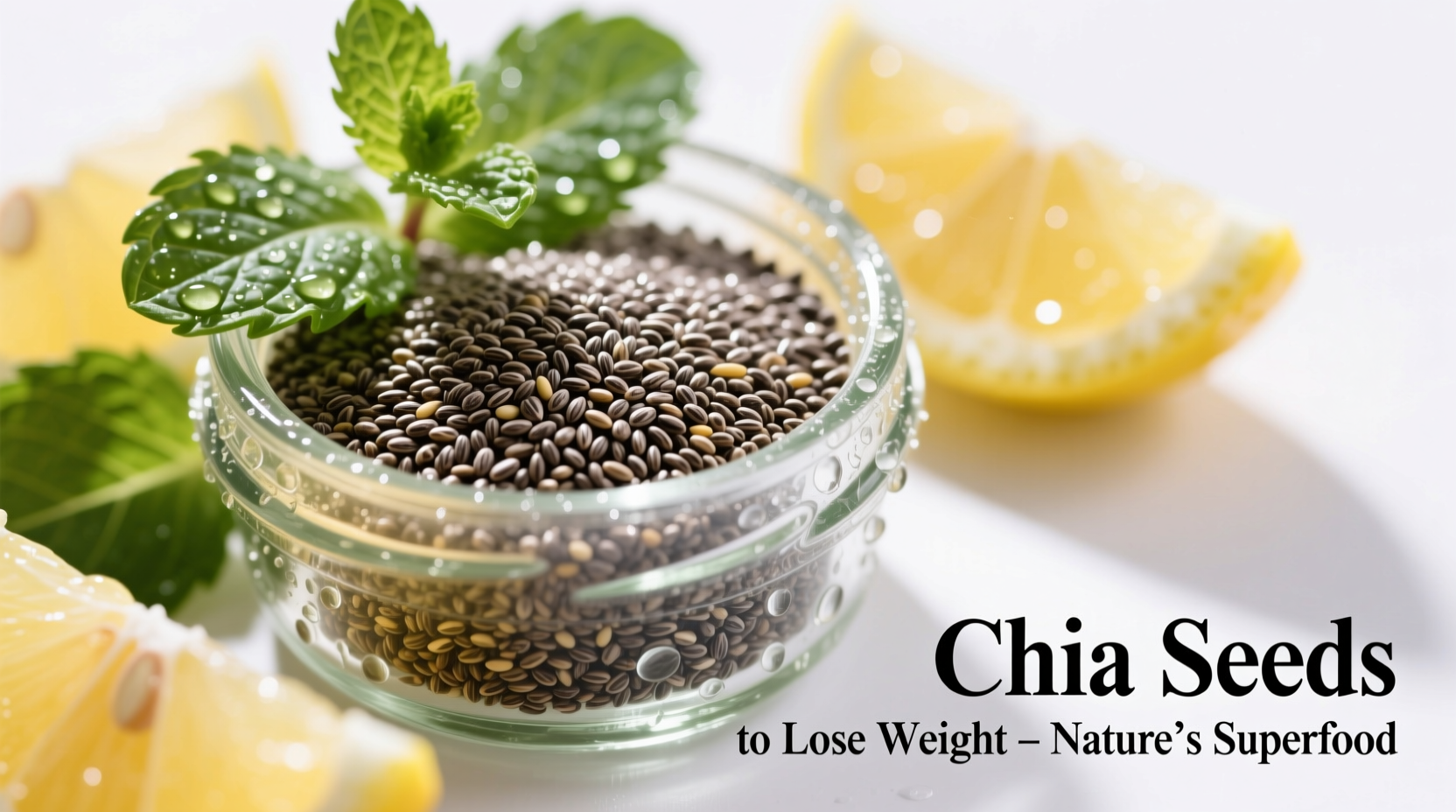Chia seeds may support weight loss through their high fiber content and ability to promote satiety, but they're not a magic solution. Research shows modest benefits when combined with a calorie-controlled diet, with studies indicating an average weight loss of 0.5-1.2 kg (1.1-2.6 lbs) over 6-12 months when replacing other carbohydrates with chia seeds. The most effective approach combines chia seeds with overall dietary improvements and regular physical activity.
Understanding Chia Seeds: More Than Just a Trend
Chia seeds (Salvia hispanica), native to Central and South America, have been valued for centuries by ancient civilizations like the Aztecs and Mayans. These tiny black and white seeds pack impressive nutritional density that makes them relevant to modern weight management strategies.
One ounce (28 grams) of chia seeds contains:
- 139 calories
- 9 grams of healthy fats (including 5 grams of ALA omega-3)
- 10 grams of dietary fiber
- 5 grams of protein
- Significant amounts of calcium, magnesium, and phosphorus
What makes chia seeds particularly interesting for weight management is their remarkable ability to absorb up to 12 times their weight in water, forming a gel-like substance that can help you feel fuller longer.

The Scientific Evidence: What Research Actually Shows
While chia seeds have gained popularity as a weight loss aid, it's crucial to examine what scientific studies actually reveal about their effectiveness.
| Study | Participants | Duration | Key Findings |
|---|---|---|---|
| NIH-funded trial (2015) | 76 adults with type 2 diabetes | 6 months | No significant weight loss difference between chia group and control group |
| Journal of Nutrition study (2017) | 195 overweight adults | 12 months | Chia group lost 0.5 kg more than control group when replacing refined carbs |
| Appetite journal research (2019) | 24 healthy adults | Single meal study | Chia pudding reduced hunger by 25% compared to control meal |
According to a comprehensive review published in Nutrition Reviews, chia seeds show modest potential for weight management primarily through their high fiber content and ability to increase feelings of fullness. However, the research consistently shows that chia seeds alone won't produce significant weight loss without accompanying dietary changes.
How Chia Seeds May Support Weight Management
Understanding the mechanisms behind chia seeds' potential weight management benefits helps set realistic expectations:
Fiber Powerhouse for Satiety
With 10 grams of fiber per ounce, chia seeds deliver more than one-third of your daily fiber needs. This high fiber content works through several weight management mechanisms:
- Slows digestion - The soluble fiber forms a gel that slows the rate at which food leaves your stomach
- Stabilizes blood sugar - Reduces blood sugar spikes that can trigger hunger
- Feeds beneficial gut bacteria - Emerging research links gut health to weight regulation
Hydration and Volume
When chia seeds absorb water (up to 12 times their weight), they increase the volume of food in your stomach without adding significant calories. This physical expansion triggers stretch receptors that signal fullness to your brain.
Healthy Fat Profile
The omega-3 fatty acids in chia seeds may help reduce inflammation, which some research suggests plays a role in obesity and metabolic health. While not directly causing weight loss, this anti-inflammatory effect supports overall metabolic function.
Practical Ways to Incorporate Chia Seeds for Weight Management
Knowing how to effectively use chia seeds matters more than simply adding them to your diet. Here's how to maximize their potential benefits:
Smart Substitution Strategy
The most effective approach isn't adding chia seeds to your existing diet, but replacing less nutritious ingredients:
- Swap 1-2 tablespoons of chia seeds for refined flour in baking recipes
- Use chia gel as a replacement for oil or eggs in recipes (1 tablespoon chia seeds + 3 tablespoons water = 1 egg)
- Replace sugary breakfast cereals with chia pudding made with unsweetened almond milk
Optimal Timing for Maximum Benefit
Research suggests consuming chia seeds before meals may enhance their satiety effects. Try:
- 30 minutes before breakfast: 1 tablespoon chia seeds soaked in water
- Before lunch: Add chia seeds to your morning smoothie
- As an afternoon snack: Chia pudding with berries
Proper Hydration is Crucial
When consuming chia seeds for weight management, adequate water intake becomes even more important. Without sufficient hydration, the fiber can cause digestive discomfort. Aim to drink an additional 8-16 ounces of water for every tablespoon of dry chia seeds consumed.
Realistic Expectations: What Chia Seeds Can't Do
It's essential to understand the limitations of chia seeds for weight management to avoid disappointment and maintain realistic expectations:
Context Boundaries for Effective Use
Chia seeds work best within specific dietary contexts:
- Not calorie-free - They contain 139 calories per ounce, so portion control matters
- Requires dietary integration - Simply adding chia to an unhealthy diet won't produce results
- Not a protein powerhouse - While they contain protein, they shouldn't replace complete protein sources
- Individual variation - Results vary based on metabolism, overall diet, and activity level
Potential Side Effects to Consider
While generally safe, chia seeds can cause issues for some people:
- Digestive discomfort (bloating, gas) when first increasing fiber intake
- Potential interactions with blood thinners due to omega-3 content
- Risk of choking if consumed dry without adequate liquid
- Possible blood pressure lowering effects that may interact with medications
The Mayo Clinic recommends starting with 1 tablespoon daily and gradually increasing to assess tolerance, and always consuming chia seeds with adequate fluids.
Creating a Sustainable Weight Management Plan
Chia seeds work best as part of a comprehensive approach to weight management. Consider these evidence-based strategies:
Realistic Integration Timeline
Here's what to expect when incorporating chia seeds into a weight management plan:
- Week 1-2: Digestive adjustment period - start with 1 tablespoon daily
- Week 3-4: Notice increased fullness between meals
- Month 2: Potential reduction in snacking frequency
- Month 3-6: Modest weight changes (0.5-1.5 kg) when combined with other healthy habits
- 6+ months: Sustainable habit formation when chia becomes part of your regular routine
Complementary Strategies for Better Results
For optimal weight management, combine chia seeds with these evidence-based approaches:
- Mindful eating practices to recognize fullness cues
- Regular physical activity (150 minutes moderate exercise weekly)
- Adequate sleep (7-9 hours nightly) - poor sleep disrupts hunger hormones
- Stress management techniques - cortisol promotes abdominal fat storage
- Consistent meal timing to regulate metabolism
Final Thoughts: Chia Seeds as One Tool Among Many
Chia seeds offer a nutrient-dense addition to a weight management plan, but they're not a standalone solution. The most successful weight management approaches combine multiple evidence-based strategies rather than relying on single "superfoods." When used appropriately as part of a balanced diet and healthy lifestyle, chia seeds can contribute to modest, sustainable weight management through their fiber content and satiety effects.
Remember that individual results vary, and what works for one person may not work for another. The key is finding sustainable dietary patterns you can maintain long-term, with chia seeds potentially serving as one helpful component of your overall strategy.











 浙公网安备
33010002000092号
浙公网安备
33010002000092号 浙B2-20120091-4
浙B2-20120091-4